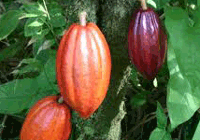
El Nino could cut global cocoa output
London, May 17, 2012
Possible El Nino weather conditions later this year could exacerbate a potential global cocoa deficit in the coming 2012/13 season, causing prices to climb, the International Cocoa Organization (ICCO) said.
"We know that when we have El Nino conditions it's likely that this will impact negatively on world cocoa production. We would have less production and this would have an impact on price," ICCO statistician Laurent Pipitone told Reuters.
"If we are in a period when we have already a deficit, and in addition we have this factor that adds to the deficit, the impact on price would be even higher," he added.
El Nino - the warming of the Pacific Ocean leading to a shift in weather patterns - caused a drop of 2.4 percent in world cocoa output on average when it occurred over the last 60 years, according to ICCO data. Such a drop equates to around 100,000 tonnes of cocoa at current production levels, Pipitone said.
The ICCO has predicted a deficit of 71,000 tonnes in 2011/12 (October-September), after a record surplus the previous year, when ideal weather boosted West African output. West Africa produces around two thirds of the world's cocoa, led by Ivory Coast.
ICE cocoa futures prices hit a 32-year high in March last year after a disputed presidential election saw a temporary ban on cocoa exports in Ivory Coast, but prices have since fallen by around 40 percent.
Pipitone said that crop prospects for the tail of West Africa's 2012/13 October-March main crop along with the 2012/13 April-September mid crop was most at risk from potential El Nino weather conditions later this year.
The ICCO bases its expectations on whether there will be El Nino conditions on predictions from the The National Oceanic and Atmospheric Administration (NOAA) and The Australian Government Bureau of Meteorology.
"A lot of the dynamical models are leaning towards a weaker El Nino developing," said Mike Halpert, deputy director of the Climate Prediction Centre, an office under the NOAA. "But given that it is still a fairly long lead forecast we're not likely to say anything more definitive on whether we'll see El Nino develop later this year until June at the earliest."
Five out of seven of the Australian Government Bureau of Meteorology's forecast models indicate El Nino conditions from September 2012, according the Bureau's website.
The effect of El Nino weather events on the cocoa crop differs according to the duration, severity and time in the crop cycle at which the weather arrives. Such weather typically means drier conditions in Malaysia, Papua New Guinea, the Philippines and Indonesia, the third's largest cocoa producer, where the harvest has fallen 2.4 percent on average during past El Nino periods.
West Africa also sees lower rainfall, with average drops of 2.03 percent and 1.72 percent in the world's first and second largest producers, Ivory Coast and Ghana. But the worst affected country is Ecuador, where the cocoa harvest shrinks 6 percent on average during El Nino, according to ICCO data.
Though it accounts for just 4.5 percent of world cocoa, Ecuador is the world's fastest growing producer, and its output is expected to grow to 175,000 tonnes in 2011/12. Pipitone said Ecuador's production was growing at a rate of around 10 percent per year.
Ecuador supplies about half of the world's fine cocoa beans, favoured for high-quality chocolate in Belgium, Switzerland, Italy and France, meaning El Nino weather could affect luxury chocolate brands in particular.
Fine cocoa beans from different countries each have a particular flavour, Pipitone said, meaning luxury brands cannot easily switch from one bean to another in the case of scarcity. "When there is a reduction of production in Ecuador it has a great impact on the finer flavour market," Pipitone said. - Reuters







